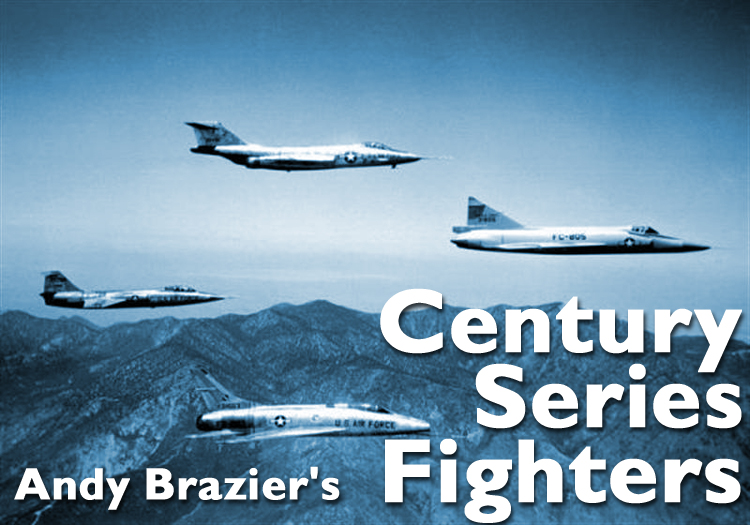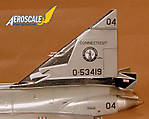1⁄48Century Series Fighters Pt. 3
...
Post a Comment

The jet age is epitomized by the legendary Century series of fighters.
The Century series aircraft, were tasked with defending the American homeland from the Soviet forces at the height of the Cold War, fighting a tenacious enemy over Vietnam and were also the backbone of NATOs nuclear strike force. They have been used as interceptors, bombers, reconnaissance and in nearly every conceivable role in between.
Convair F-102 Delta Dagger
Evolved from wartime German research records, the Convair F-102 and the 2 seat TF-102A was the first delta wing fighter to enter service. Its frontline career was brief but 3 times as many "Deuces" were built then its successor, and saw service with far more units, including 2 foreign airforces.The F-102 was developed from the XF-92A delta wing research aircraft of the late 1940s. The Air Force took a new approach in putting out the request for proposals for an operational interceptor, considering both the aircraft and armament together in what became known as a "weapon system". The RFP for Project MX-1554 went out 18 June 1950, and in January 1951 six manufacturers responded, of which Convair, Lockheed, and Republic were chosen to proceed with design. Three of these projects were too expensive, and in November, only Convair was allowed to continue with its Model 8-80, an interim project using the less-powerful Westinghouse J40 turbojetin lieu of the Wright J67 which was still in development.The YF-102 made its first flight on 24 October 1953, but was lost in an accident nine days later.
The second aircraft flew on 11 January 1954, confirming a dismal performance: Approximately 812 mph, while supersonic, it was far below the requirements. The problem was solved by the use of the area rule, which entailed narrowing the aircraft down in the mid-section, moving the cockpit and intakes back further, blending the outer contours of the intake duct, lengthening the nose and adding two fairings on either side of the engine nozzle, resulting in the new "'YF-102A design'". The new design was more than twice as fast as the non-area ruled design.
The "'YF-102A'", however was not exactly the same as the production F-102A design in that its nose was considerably longer than the "'F-102A". Somewhere along the way, the Wright J-67 was cancelled, and the J-40 was replaced with a Pratt & Whitney J-57. The production F-102A had the Hughes MG-3 fire control system, later upgraded in service to the MG-10. It had a three-segment internal weapons bay under the fuselage for air to air missiles. Initial armament was three pairs of GAR-1 Falcon missiles, a mix of infrared and semi active radar homing. The doors of the two forward bays each had tubes for 12 x 2.75 in FFAR rockets (for a total of 24). The F-102 was later upgraded to allow the carriage of an GAR-11 Nuclear Falcon missiles in the center bay. The larger size of this weapon required redesigned center bay doors with no rocket tubes. Plans were considered to fit the MB-1 Genie nuclear rocket to the design, but it was never adopted.
The first operational service of the F-102A was with the 327th Fighter - Interceptor squadron at George Air Force Base, in April 1956, and eventually a total of 889 were built. The F-102's official name, "Delta Dagger" was never used in common parlance, with the aircraft being universally known as the "Deuce."
The F-102 served in Vietnam, flying fighter patrols and serving as bomber escorts. A total of 15 aircraft were lost in Vietnam: one to air-to-air combat, several to ground fire and the remainder to accidents.
In 1973, six aircraft were converted to target drones as QF-102A and later PQM-102 series, simulating MiG 21s. This began a program where hundreds of F-102s were converted for use as target drones for F-4 and F-106 aircraft as well as later F-15 aircraft and testing of the US Army's Patriot missile system.
Some F-102As were configured to accommodate a single AIM-26 Super Falcon in each side bay in lieu of the conventional 2 x AIM-4 Falcons.
The F-102 and TF-102 were exported overseas to both Turkey and Greece, with those aircraft seeing combat missions during the 1974 Turkish invasion of Cyprus. There have been claims of air combat between Greek F-5s and Turkish F-102s. The Greeks claimed to have shot down two F-102s while the Turks claim to have shot down an F-5; however, both sides deny losses. The F-102 was finally retired from both of those air forces in 1979. The F-102 left US service in 1976, while the last PQM-102 drone was expended in 1986. No F-102s remain in flyable condition today although many can be seen at museums.
Variants
YF-102 - The first prototypes: Performance was unsatisfactory; drag was twice as high as it should have been due to interference-effects. Maximum Speed: 812 miles per hour.YF-102A - Area-ruled prototypes: New design featured a fuselage that was narrow in the mid-section, with aerodynamic fairings added on either side of the engine-nozzle to conform to the area-rule. Additionally, cockpit and intakes were moved further aft, the nose lengthened, and the outer contours of inlets were blended with the forward fuselage.
F-102A - Production Model: Single-seat all-weather interceptor fighter aircraft. Nose shorter than original F-102A, but featuring more powerful J-57 turbojet. 889 built.
TF-102A - Two-seat training version, 111 built.
F-102B - The original designation of the F-106A.
QF-102A - Two piloted target drones, (converted from the F-102A).
PQM-102A - 200+ unpiloted target drones, (converted from F-102A).
PQM-102B - Unpiloted target drones.
The model
Revell 1/48th F-102 Delta Dagger. Built out of the box. Xtracrylix acrylics used for the ADC Grey and Interior green for the wheel wells and missile bay.Markings for the 118th Fighter Interceptor Squadron, Connecticut Air National Guard, Bradley International Airport, USA, Summer 1968.
Copyright ©2021 by Andy Brazier. Images also by copyright holder unless otherwise noted. The views and opinions expressed herein are solely the views and opinions of the authors and/or contributors to this Web site and do not necessarily represent the views and/or opinions of AeroScale, KitMaker Network, or Silver Star Enterrpises. Images also by copyright holder unless otherwise noted. Opinions expressed are those of the author(s) and not necessarily those of AeroScale. All rights reserved. Originally published on: 2007-07-22 00:00:00. Unique Reads: 13014


















